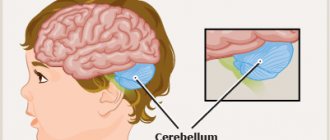Causes and provoking factors
To date, there is no confirmed data on what provokes the development of such a disease.
Scientists suggest that the causes of the anomaly may be infectious diseases that the woman suffered during pregnancy (measles, rubella, etc.), ingestion of toxic substances (alcohol, nicotine, drugs, etc.), intrauterine trauma or genetic disorders in fetal development. Very often, this pathology is accompanied by disturbances in the development of the organs of the genitourinary system.
The first trimester of pregnancy is considered the most dangerous period, so a woman needs to pay special attention to her health at this time. Often this pathology develops in patients with diabetes mellitus.
Doctors have still not been able to establish the exact causes of the development of Dandy-Walker syndrome. Doctors identify the following etiological theories:
- primary disorder of the development of brain structures;
- increased production of cerebrospinal fluid during embryogenesis.
The negative impact of environmental factors can serve as a provocateur for the development of pathology. The most common triggers are:
- smoking and excessive alcohol consumption during pregnancy;
- taking narcotic drugs;
- exposure to ionizing radiation;
- history of intrauterine trauma;
- viral infection (herpes, measles, rubella, cytomegalovirus);
- diabetes;
- disruption of metabolic processes in the mother's body;
- taking antibacterial agents during pregnancy.
The above factors have the greatest impact in the first trimester of pregnancy. This is due to the fact that during this period the formation of the structures of the central nervous system occurs. Among the causes of the development of Dandy-Walker syndrome, hereditary predisposition plays an important role. If one of the relatives had this pathology, subsequent generations are at risk.
There are many reasons why Dandy Walker syndrome may develop in children.
Measles and rubella affect the fetus in the following way: these viruses literally “consume” the tissue around the embryo. Because of this, defects in brain tissue often occur, which leads to Dandy Walker syndrome.
Antibiotics, in turn, can affect the baby’s central nervous system, which can also cause the disease.
If the mother has diabetes, the likelihood of Dandy Walker syndrome increases several times. Due to the woman's illness, the fetus does not receive enough of the substances it needs, so its cerebellum does not develop.
Modern medicine cannot say with sufficient precision why certain intrauterine developmental defects occur. Of course, there are certain risk factors that can lead to a congenital anomaly in the fetus. In the formation of Dandy Walker syndrome, the cause is often viral diseases suffered by the mother during pregnancy, especially in the first three months.
Very often, pathology in the development of a pregnant child is observed in women suffering from chronic alcoholism. It is these mothers, in the majority of identified cases of the disease, who give birth to children suffering from Dandy Walker syndrome. This is due to the fact that the overwhelming number of women who abuse alcohol are extremely irresponsible when it comes to bearing a child.
It should be noted that the causes of Dandy Walker syndrome may also be hereditary. However, sporadic cases of the disease are most common. This causes a feeling of confusion in future parents who learn about the confirmation of such a diagnosis, and puts them before a serious choice.
Timely detection of pathology
Due to the genetic nature of the disease, it is impossible to prevent its occurrence. However, during the period of gestation, it is very important to carry out the necessary measures to diagnose this syndrome in the fetus.
For this purpose, a pregnant woman is prescribed ultrasound examinations, which should be performed at least once every three weeks. A magnetic resonance imaging procedure is also prescribed to clarify the diagnosis and identify the location of the lesion.
In addition, diagnostic testing for the presence of antibodies to viral diseases such as rubella and measles is mandatory. If such antibodies are detected during the analysis, an ultrasound examination of the fetus is performed to assess the extent of its damage.
It should be remembered that drinking alcoholic beverages has a very negative impact on the intrauterine development of a child. Therefore, during pregnancy you should give up bad habits.
Dandy-Walker syndrome is a congenital pathology, which is expressed in the form of underdevelopment of the cerebellum and cerebrospinal fluid tracts:
- The opening through which the third and fourth ventricles of the brain are connected to the cisterna magna (medial or foramen of Magendie);
- The hole connecting the cavity of the fourth ventricle of the brain with the subarachnoid space of the meninges (lateral or foramen of Luschka).
The characteristic signs of the anomaly are the following triad of symptoms:
- Hypotrophy of the cerebellar hemispheres and/or its vermis (that is, the middle, phylogenetically ancient part, which is located between the hemispheres);
- The appearance of cystic formations (fistulas) in the posterior cranial fossa;
- Hydrocephalus (in other words, dropsy of the brain, which is accompanied by increased intracranial pressure) of varying severity.
Also, patients with Dandy-Walker syndrome have cystic dilatation (persistent diffuse dilatation) of the fourth ventricle of the brain, atresia (congenital absence or acquired fusion) of the foramina of Luschka and Magendie, and increased size of the posterior cranial fossa.
Dandy Walker anomaly, symptoms
This disease is a very serious illness.
It is a defect in the development of certain parts of the brain.
Sometimes the causes leading to the disease can get worse; then Dandy Walker syndrome can lead to a critical condition of the patient.
The syndrome can be detected during the development of the fetus in the womb. If the illness is confirmed, the child is immediately registered with a specialist.
The disease is quite rare - approximately 1 child out of 25,000 newborns has Dandy Walker syndrome.
The types of syndrome differ only in the degree of underdevelopment of the cerebellum. If it is severely underdeveloped, the disease occurs with the presence of the main symptom - hydrocephalus.
In the event that the underdevelopment of the cerebellum is not so severe, the disease can proceed without changing the condition of the brain bones and some other symptoms.
Only a doctor can determine the extent of damage to the cerebellum. To do this, it is necessary to conduct a series of studies, which will be discussed below.
The following links are distinguished in the pathogenesis of Dandy-Walker syndrome:
- pathology of the cerebrospinal fluid pathways;
- accumulation of cerebrospinal fluid in the ventricles;
- compression of areas of the brain as a result of pathological accumulation;
- increased intracranial pressure;
- pathology of the cranial nerve nuclei;
- development of the first pathological symptoms;
- formation of cysts filled with cerebrospinal fluid;
- gradual increase in cystic formations in size;
- development of deformation of the skull bones;
- compression of other brain structures;
- decrease or complete absence of the functional ability of the brain.
The first symptoms of the disease can be diagnosed using ultrasound diagnostics. The main pathological signs include:
- the presence of cysts or tumor formations in the brain area;
- reduction of the cerebellum, impairment of its functional abilities;
- kidney dysfunction;
- cleft palate or upper lip;
- fistulas in the brain area;
- ventriculomegaly;
- disruption of the development of the liquor drainage system.
Today, Dandy-Walker syndrome is recognized by most doctors as a congenital developmental anomaly. However, pathological signs of the disease can appear in a child of any age. There are cases when the syndrome was first diagnosed in an adult.
The first signs of Dandy-Walker syndrome are:
- hydrocephalus;
- cysts or fistulas in the brain area;
- developmental disorder of the cerebellar hemispheres;
- an increase in the size of the posterior part of the cranial fossa;
- fusion of the liquor ducts.
The above symptoms can be diagnosed using ultrasound. Therefore, pregnant women need to undergo screening examinations in a timely manner.
- disproportionate size of the head compared to the body;
- facial nerve neuropathy;
- strabismus;
- convulsive syndrome, which manifests itself in the muscles of the limbs;
- nystagmus;
- facial development disorder;
- emotional lability;
- heart rhythm disturbance;
- apnea;
- bulging fontanel;
- pathology of the development of cranial bones.
- Cerebellar damage:
- lack of coordination of movements;
- dizziness;
- nystagmus;
- tremor;
- gait disturbance;
- inability to perform quick actions;
- chanted speech.
- Movement violation:
- convulsive syndrome, which is characterized by high frequency;
- increased tension in the muscles of the trunk and limbs.
- decreased visual acuity;
- double vision.
- feeling of nausea;
- constant headache, more pronounced in the morning;
- dizziness;
- pale skin;
- emotional lability;
- severe weakness, loss of strength;
- photosensitivity;
- inhibition of reactions;
- decreased concentration.
- forgetfulness;
- lack of reading and writing skills;
- inability to remember letters.
- periodic aching pain in the lumbar region;
- increased blood pressure values;
- edema syndrome expressed in the face and limbs;
- discomfort when urinating;
- pathological impurities in the urine (blood, sediment).
- shortness of breath with moderate physical activity;
- tachycardia;
- cyanosis of the skin;
- frequent fainting;
- edema syndrome;
- pain in the heart area.
- changes in facial structure;
- increase in head size.
A developmental anomaly in the fetus can be diagnosed at 18-20 weeks of development. This requires an ultrasound. At this stage, it is possible to visualize the pathology of the cerebellar vermis. Doctors note that in rare cases, earlier diagnosis of Dandy-Walker syndrome is possible.
There are several forms of Dandy Walker syndrome. Let's consider the main ones:
- Prenatal period:
- Full form. Characterized by underdevelopment of the cerebellum. In this case, the worm is absent, and the cyst is connected to the fourth ventricle.
- Incomplete form. Accompanied by a partial developmental defect. The structure of the cerebellum is visible in places during ultrasound diagnostics. The incomplete form of Dandy-Walker syndrome is characterized by intermittent communication of the fluid cavity with the worm.
- Open form. Characterized by the patency of the liquor pathways.
- Closed form. This type of Dandy-Walker syndrome is characterized by fusion of the cerebrospinal fluid ducts.
Possible complications of Dandy-Walker syndrome include the following conditions:
- brain necrosis;
- dropsy;
- cerebrovascular accident;
- functional disorders of internal organs;
- decreased visual acuity;
- mental disorders;
- disturbance of mental activity;
- incoordination;
- death.
Diagnosis of Dandy-Walker syndrome is:
- prenatal (examination during pregnancy);
- postnatal (in the postpartum period).
If Dandy-Walker syndrome is detected in the fetus, parents make a decision on further pregnancy or termination of pregnancy. Let's consider the main methods for diagnosing congenital genetic anomalies.
Ultrasound is considered the main diagnostic method. The examination is harmless and painless, it can be carried out in the early stages. Ultrasound can detect Dandy-Walker syndrome at 2-3 months of gestation. The study is recommended to be performed every trimester. If a fetal abnormality is suspected, the woman is sent for an MRI.
You can determine your susceptibility to congenital genetic diseases through medical genetic counseling. It is indicated for couples who have had hereditary diseases in their family.
Dandy-Walker syndrome must be differentiated from arachnoid cysts. A distinctive feature of the latter is compression of the cerebellum without its rotation. Cysts formed as a result of Dandy-Walker syndrome rotate counterclockwise.
Dandy-Walker syndrome is an incurable congenital disease. It cannot be treated. Palliative care is provided to patients and their parents. Treatment includes medication and surgery. The volume of therapy is selected depending on the severity of pathological symptoms. The child should be regularly examined by a pediatrician, neurologist and neurosurgeon. Among the drugs prescribed for Dandy-Walker syndrome are:
- Sedatives. They help normalize the child’s emotional background, eliminate irritability and moodiness.
- Painkillers. They reduce the severity of pain and have an anti-inflammatory effect.
- Vitamin complexes. Improves the process of transmission of nerve impulses.
- Diuretics. Helps lower blood pressure. Drugs in this group remove excess fluid from blood vessels.
- Corticosteroids. Prescribed to reduce the amount of cerebrospinal fluid produced in the ventricles of the brain.
- Vasodilators. They stabilize blood microcirculation in the vessels and expand their lumen. Thanks to vasodilators, it is possible to facilitate the outflow of liquor fluid.
- Plasma substitutes. Reduce the progression of pathological symptoms of Dandy-Walker syndrome. Helps maintain brain function.
- Beta blockers. Prescribed to reduce edema syndrome.
In addition to drug treatment, patients with Dandy-Walker syndrome are prescribed physical therapy. It includes:
- mud therapy;
- salt baths;
- massage.
Physiotherapeutic treatment is used to reduce muscle hypertonicity and normalize the patient’s emotional background.
The indication for surgical intervention is the need to create a new pathway for the outflow of cerebrospinal fluid. The operation is performed using the following methods:
- Ventriculo-peritoneal shunt. The operation involves inserting a soft tube into the cavity of the ventricle. Next, the catheter is directed into the abdominal cavity. It is performed subcutaneously behind the ear and in the collarbone area. The manipulation is performed to drain and absorb brain fluid in the abdominal cavity.
- Endoscopic ventriculostomy. It involves making a hole in the skull bone. The neuroendoscope is advanced into the ventricle. Using the tool, excess liquid is removed. Endoscopic ventriculostomy is considered a minimally invasive procedure. The operation does not cause late complications.
Doctors warn that surgery is carried out to eliminate hydrocephalus. Restoring mental and neurological functions in this way is impossible. At the Yusupov Hospital, operations are performed by experienced surgeons.
Congenital genetic diseases cannot be prevented. Pathology in the fetus can be detected in a timely manner using ultrasound diagnostics. Doctors advise pregnant women to undergo examinations every trimester.
In order to reduce the risk of developing Dandy-Walker syndrome in the fetus, women during pregnancy are recommended to:
- stop smoking;
- exclude the consumption of alcoholic beverages;
- adhere to the principles of a balanced and rational diet;
- Take regular walks in the fresh air.
Dandy Walker anomaly, symptoms
The symptoms of Dandy Walker syndrome are almost the same for everyone. They can be divided into internal symptoms, which hardly appear visually, and external ones, which are clearly visible (see photo above).
Internal signs of the syndrome:
- delayed development of fine motor skills;
- slow movements;
- The child has frequent headaches, which is why he often cries and becomes irritable.
External signs:
- hydrocephalus. The main sign of a child having Dandy Walker syndrome. The “fontanel” will constantly pulsate. Because of this, the back of the skull will grow much faster than the front; the head will appear enormous in size;
- “protrusion” of the bone at the back of the head;
- large fontanelles;
- soft cranial bones;
- bent limbs;
- involuntary eye movements.
It must be remembered that each child, due to certain factors, can develop faster or slower. This will also determine how quickly the symptoms of Dandy Walker syndrome appear.
It is also necessary to take into account the severity of symptoms - in some patients they are extremely mild, in others they are pronounced.
If for some reason an ultrasound examination of the fetus was not performed, Dandy Walker's pathology is detected, in most cases, almost immediately after the birth of the child. Due to increased intracranial pressure, the baby behaves very restlessly, he develops hydrocephalus, muscle spasms, and involuntary oscillatory eye movements - nystagmus. It is possible for the disease to progress without signs of hydrocephalus.
At older ages, Dandy Walker syndrome begins to manifest itself with cerebellar symptoms. The child's coordination of movements is impaired, which creates problems when walking, up to the impossibility of independent movement. The main symptom of the disease is significant intellectual underdevelopment, which is practically not subject to correction.
Dandy-Walker syndrome was discovered by American scientists. It is more common among female patients and is characterized by an underdeveloped cerebellum, disruption of the cerebrospinal fluid ducts and the presence of a tumor in the cranial cavity.
The cerebellum is one of the important parts of the brain; it is located in the back of the brain. Thanks to its functioning, a person can control his movements, regulate the tension and relaxation of the muscles. With Dandy-Walker pathology, the cerebral hemispheres are much smaller than normal, as is the middle part, which separates the two hemispheres. In some patients, the vermis (separation between the hemispheres) is completely absent.
The cerebrospinal fluid ducts connect the third and fourth ventricles and the cerebral cistern. They carry the movement of cerebrospinal fluid, which carries essential nutrients. In Dandy-Walker syndrome, such cerebrospinal fluid pathways are fused with each other or are completely absent.
As a result, the child is diagnosed with hydrocephalus, a strong increase in the size of the fourth ventricle, increased intracranial pressure, and the formation of a cerebrospinal fluid cyst. Thus, this syndrome is considered a very dangerous pathology, which entails the development of severe consequences. Very often, children with this diagnosis remain disabled for the rest of their lives.
Walker syndrome can be detected by undergoing a routine ultrasound examination at 20 weeks of pregnancy. The main features include:
- reduction in the size of the cerebellum;
- an increase in the size of the third and fourth ventricles of the brain;
- cystic formation in the occipital fossa of the skull.
In newborn children, signs of hydrocephalus may be observed: an increase in the size of the skull, pain in the head, ataxia (uncoordinated movements), severe tearfulness and irritability. In addition, there is a strong pulsation of the fontanelle in newborns. They are far behind their peers in development and have impaired motor skills due to an underdeveloped cerebellum.
In older children with Dandy-Walker anomaly, somatic disorders occur: problems in the development of the heart and kidneys, pathologies in the face and lower extremities, and visual impairment. If such a disease is diagnosed in adulthood and no severe symptoms are observed, then the following symptoms occur:
- severe headaches;
- nausea and vomiting;
- convulsions;
- problems with coordination;
- developmental problems (the patient speaks, writes poorly, etc.).
The severity of symptoms depends on the type of syndrome, which is determined by the degree of underdevelopment of the cerebellum (complete or incomplete form). This can only be determined using instrumental diagnostics.
Pathogenesis of the disorder
The disease develops in one of the parts of the brain - the 4th ventricle. Liqueur fluid accumulates in this section. As a result of underdevelopment of the cerebrospinal fluid pathways, there is no passage and excessive accumulation of this fluid.
Under the influence of a large volume of cerebrospinal fluid, pressure occurs on nearby brain structures. The nuclei of the cranial nerves exit into the cavity of the 4th ventricle, and when exposed to high pressure, excitation is transmitted through these nerves, which is fraught with certain symptoms.
Constantly accumulating fluid leads to the formation of the posterior fossa of the skull, which gradually grows and can reach large sizes. As a result, the skull is deformed, and those brain structures that are located next to the ventricle do not develop fully.
Depending on the violation of the anatomical structure, two forms of pathology are distinguished:
- complete
- characterized by complete underdevelopment of the cerebellar vermis; - incomplete
- part of the brain has only partial underdevelopment.
Also, the Dandy-Walker anomaly may be accompanied by the development of cerebral hydrocele, but the disease will not always be accompanied.
Possible complications and prognosis
With the congenital form of Dandy-Walker syndrome, children remain mentally retarded and unable to lead a full life. Among the main complications of the pathology are severe forms of hydrocephalus and impaired coordination of movements.
Detection of the syndrome in the early stages allows for effective treatment and maximum relief of the child from existing defects caused by the Dandy anomaly.
Often, when a pathology is detected during ultrasound diagnostics during pregnancy, a woman is offered to terminate the pregnancy. This is a very difficult choice that parents must make. It must be remembered that a baby born with Walker syndrome in 95% of cases remains disabled for life and requires special care.
Manifestation of the disease
The discovery and detailed study of Dandy-Walker malformation in the last century made it possible to identify a triad characteristic of this pathology.
It includes the following signs: absence of the worm (or its partial development), neoplasms of the ventricle of the cystic type, deviation from the anatomical norm of the posterior cranial fossa (in a larger direction). The sinuses move upward, which is another sign. The cerebellum also changes its normal position. Underdeveloped pathways for the movement of cerebrospinal fluid lead to the formation of hydrocephalus. The percentage here is high - almost 90% of patients experience discomfort due to the accumulation of cerebrospinal fluid in the ventricular system.
If we talk about the varieties of the disease, then there are two of its forms - complete and incomplete. In the complete form, the cerebellar vermis is completely absent; the incomplete form is characterized by partial underdevelopment of the cerebellar parts.
Among congenital pathologies of the development of the nervous system, many diseases belong to the class of dangerous. Dandy-Walker malformation turns out to be one of the most difficult diseases in terms of the course, treatment and subsequent prognosis. The mental development defect in this disorder is irreversible. The neurological status may also remain for life - muscle hypertonicity and improper coordination of movements will be observed.
Diagnostic methods
If Dandy-Walker disease began to manifest itself after birth, then the doctor should listen to the main complaints of the patients (in the case of babies, the complaints of the parents) and prescribe the following types of studies:
- Ultrasound of the brain - neurosonography, is carried out before the child’s fontanel has healed;
- determination of nystagmus (involuntary eye movement), muscle hypertonicity and head proportions in the baby (carried out by a neurologist);
- Computed tomography is performed on older patients. With its help, it is possible to establish precise abnormalities in the development of certain areas of the brain.
Additional studies include ultrasound examination of the heart and genitourinary system. Today, magnetic resonance imaging remains a popular method, which allows us to identify the presence of possible cysts in the cranial fossae and the degree of hydrofecality.
Before starting a diagnosis, you need to find out whether a similar disease has existed in the family before, when the very first symptoms began to appear. After this, you need to contact your doctor for a referral for tests and procedures.
To determine Dandy Walker syndrome, you must undergo the following procedures:
- MRI. Allows you to identify the degree of enlargement of the skull, the presence of cysts, enlargement of the ventricle and the degree of underdevelopment of the cerebellum.
- Ultrasonography. It is carried out during gestation in order to determine the first signs of the development of the disease. In addition, the study is used to determine complications in the heart and other organs in cases of advanced stages of the syndrome.
- Neurological examination. The procedure helps to identify the presence of involuntary movement of the patient's eyeballs, enlargement of the fontanel zone, increase in the size of the skull and decreased tone of the body muscles.
To determine the presence of the syndrome, in some cases it is necessary to consult a neurosurgeon and a medical geneticist.
Clinical picture
The syndrome can be detected during pregnancy using ultrasound in the fifth month of pregnancy. In this case, the embryo will show the following signs:
- cerebellar hypotrophy;
- enlargement of the 4th ventricle;
- cyst in the cranial fossa.
A newborn with Dandy-Walker syndrome will exhibit the following symptoms:
- large head size, it will be disproportionate in relation to the body;
- thinning and protrusion of the bone in the back of the head;
- dropsy of the brain (optional);
- cranial bones are soft;
- large size of fontanelles;
- faint cry;
- constant crying due to severe headaches;
- anomalies in the structure of the facial bones;
- - involuntary oscillatory movements of the eyeballs in different directions;
- convulsive trembling of the lower and upper extremities;
- increased muscle tone of the limbs, which leads to their rigidity, they are in a bent position;
- slow development of motor skills.
Despite the fact that the defect is congenital, very rarely signs of the syndrome can be detected at the age of four years or even later.
Also in medicine, exceptional cases were described when Dandy-Walker syndrome manifested itself in adults. In this case, the symptoms will be as follows:
- severe nausea and vomiting;
- increased irritability;
- seizures;
- significant visual impairment;
- change in the shape of the skull - the bones of the back of the head begin to protrude;
- loss of coordination, movements become sweeping, gait is unsteady;
- decreased intelligence - a person is unable to write and read, ceases to recognize relatives.
Very often, anomalies are accompanied by various pathologies, including:
- heart disease;
- kidney dysfunction;
- fusion of fingers and toes;
- cleft palate and cleft lip.
What children with Dandy Walker syndrome look like in real life - photo and video materials:
Treatment
After receiving the results of a comprehensive examination, the doctor selects an effective treatment regimen. Unfortunately, it is impossible to influence the cause of the development of such a syndrome. In most cases, symptomatic treatment is carried out.
To reduce intracranial pressure and improve the circulation of cerebrospinal fluid, doctors perform surgical bypass surgery of the fourth ventricle of the brain.
In severe forms of Dandy-Walker syndrome, 99% of patients will die. If a child is diagnosed with a pathology of moderate severity, the doctor decides on an effective treatment regimen. To reduce muscle hypertonicity, regular therapeutic massage and a set of physiotherapeutic procedures are performed. This will help slightly reduce the signs of hydrocephalus.
Children born with Dandy syndrome are, in most cases, severely delayed in development and are constantly monitored by a neurologist. They have problems with movement, many simply cannot move. Mental retardation today cannot be treated; children with Dandy-Walker anomaly remain disabled.
As part of complex therapy, various medications are prescribed (diuretics, neuroprotectors, antispasmodics, etc.). They help cope with headaches, problems in the functioning of the genitourinary system, etc. The dosage and duration of treatment are selected by the doctor individually for each patient.
Treatment of such an anomaly is practically meaningless. However, with increasing hydrocephalus, surgical intervention is required. To reduce intracranial pressure, shunting of the fourth ventricle of the brain is performed, which promotes the outflow of cerebrospinal fluid. With Dandy Walker syndrome, treatment is only symptomatic, since the patient’s intellectual underdevelopment cannot be corrected. The motor function of his body is also significantly impaired. In severe cases, the child does not walk or sit independently.
In addition, you need to remember about the diseases associated with Dandy Walker syndrome. Many of them require medical intervention. These include heart defects, kidney development anomalies, and maxillofacial pathology. These diseases significantly complicate the already difficult underlying diagnosis.
The detection of a Dandy Walker anomaly in a fetus presents potential parents with a choice - to terminate the pregnancy or give birth to a child with an incurable pathology. In this situation it is difficult to advise anything. However, when deciding to prolong pregnancy, you should remember that a sick baby will need parental help throughout its life.
Treatment for this disease makes virtually no sense. Despite this, in some cases treatment is carried out. Sometimes this even leads to success.
It is worth saying that even with a successful outcome of treatment, the child will not be healthy. He will still have some signs (usually visual) that indicate he has Dandy Walker syndrome.
Drug treatment is prescribed only in cases of mild disease. In such a situation, the patient is prescribed diuretics (for example: Mercuzal, Promeran, Novurit), which reduce the level of fluid in the skull, relieve headaches and dizziness.
Surgery
If the enlargement of the skull begins to progress, surgical intervention is necessary. In this operation, the goal is to reduce intracranial pressure by shunting the fourth ventricle of the brain.
Surgery is also possible to improve the drainage of fluid from the brain and reduce the size of the child’s head.
In other cases, surgery is not used for this disease.
Home Remedies
Unfortunately, treating such a serious illness as Dandy Walker syndrome is impossible at home. Parents can only help their child with soothing decoctions if the patient has a high degree of irritability. In addition, it is permissible to use other non-traditional remedies to relieve a child of headaches and dizziness.
Some doctors advise hardening children who have Dandy Walker syndrome. But this is a rather controversial point of view. In this matter, consultation with the child’s attending physician is necessary. As practice shows, in most cases of hardening, the symptoms worsen, and the child’s condition approaches critical. In view of this, the opinions of doctors are divided from a categorical “no” to an unconditional “yes”.
What can be done?
Unfortunately, in general, treatment of this disease does not make sense; all procedures used in this case will be symptomatic. This pathology has varying degrees of severity in each individual case.
Basically, children who develop a severe form of the disease die within the first month of life. If the anomaly is still compatible with life, then the physiological and mental development of the child is considered very problematic.
Mental retardation cannot be treated; motor functions will be impaired, i.e. the child is unable to sit and stand without assistance. First of all, parents must understand that the baby will have a fairly low level of intelligence, which cannot be corrected.
If progression is observed, surgical treatment is performed by shunting the 4th ventricle of the brain. This operation is performed to reduce intracranial pressure due to the outflow of cerebrospinal fluid.
During treatment, it is necessary to take into account the presence of concomitant pathologies of the heart, kidneys, and maxillofacial disorders. They require adequate medical treatment.
If during pregnancy the attending physician detects an anomaly in the fetus, it is recommended to terminate the pregnancy artificially.
Prevention
There are no specific measures to prevent Dandy-Walker disease. During pregnancy, women are advised to monitor their health and avoid drinking alcohol and tobacco products.
It is worth noting that drug addicted women have a 90% chance of having a child with this disorder. In addition, you need to avoid possible infectious diseases, undergo preventive examinations in a timely manner and take the necessary tests.
Dandy-Walker syndrome is not very common. This is a congenital genetic disease, which is accompanied by underdevelopment of the cerebellum and cerebrospinal fluid tracts. As a result, a patient with such a diagnosis cannot fully develop mentally and physically. His coordination of movements, motor skills, etc. are impaired.
Considering that the disease is largely hereditary, prevention is useless.
Doctors give recommendations to visit a gynecologist while carrying a child and undergo the necessary examinations, which can reveal pathologies in the development of the fetus in the early stages of pregnancy.
In other cases, doctors and specialists in this field consider preventing the disease to be absolutely impossible.












